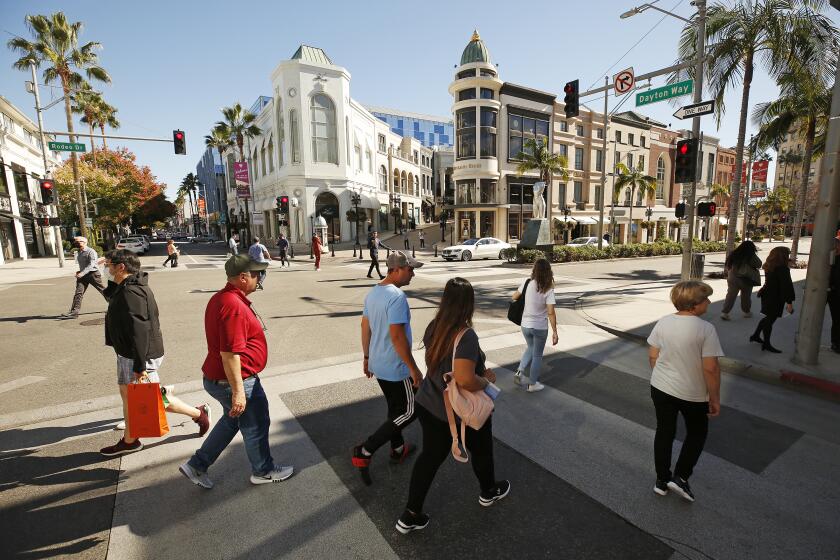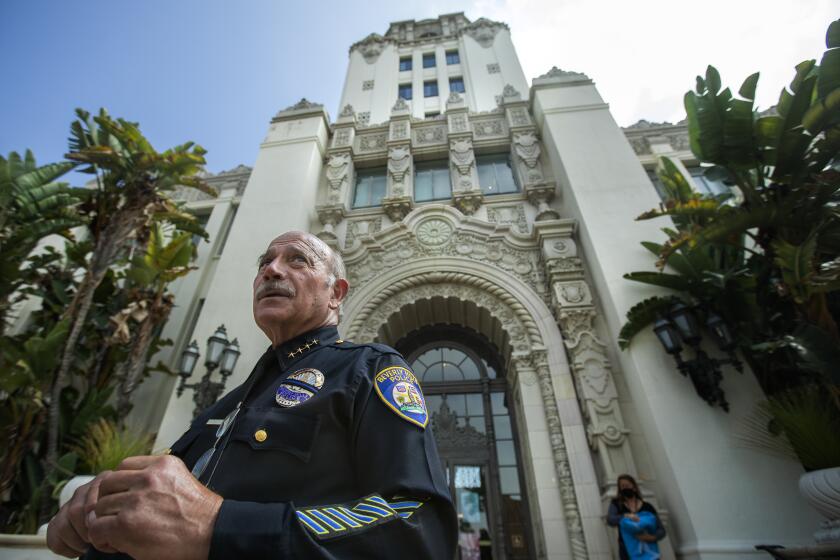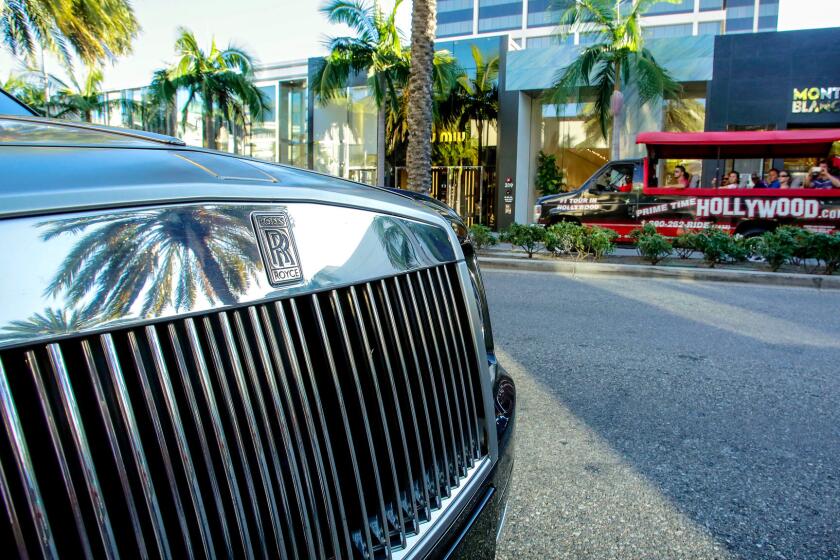Beverly Hills is always watching you with thousands of cameras. And the city isn’t done
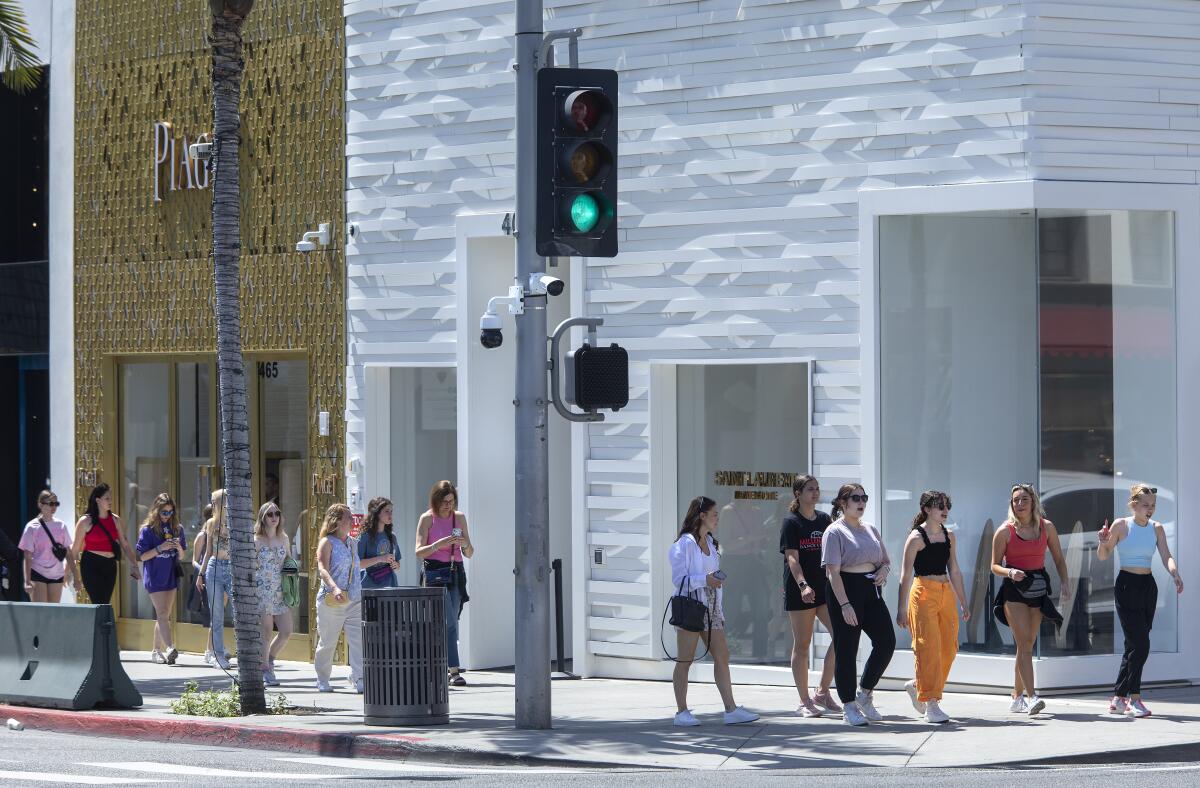
Travel along Wilshire Boulevard in Beverly Hills and digital eyes follow you. The same goes for Olympic Boulevard. And Rodeo Drive. And more.
For years, the Los Angeles enclave synonymous with exclusivity and privilege has been building a network of surveillance cameras that today covers much of its bustling shopping district and many residential areas.
The city has about 2,000 closed-circuit cameras — nearly 1 for every 17 residents — along with others at many intersections that snap photos of drivers going through red lights, as well as drones and dozens of devices that can read license plates and automatically check them against law enforcement databases to find unregistered plates or stolen vehicles.
And city leaders aren’t done. At a meeting in August 2020, when the City Council unanimously approved the purchase of a few hundred more surveillance cameras, Assistant City Manager Nancy Hunt-Coffey laid out a five-year proposal to spend $14 million for an additional 900 cameras and 50 more license plate scanners.
The ultimate goal?
“Ubiquitous coverage,” Hunt-Coffey said.
Such ambitions have kept Beverly Hills squarely at the center of a debate here and elsewhere over how cities should combat robberies, thefts and other crimes targeting luxury stores and wealthy people.
City officials reason that the cameras pose no threat to people who don’t break the law and say they serve as both a deterrent to would-be criminals and an indispensable tool for detectives trying to solve crimes like the armed robbery of a man’s half-million-dollar watch last year.
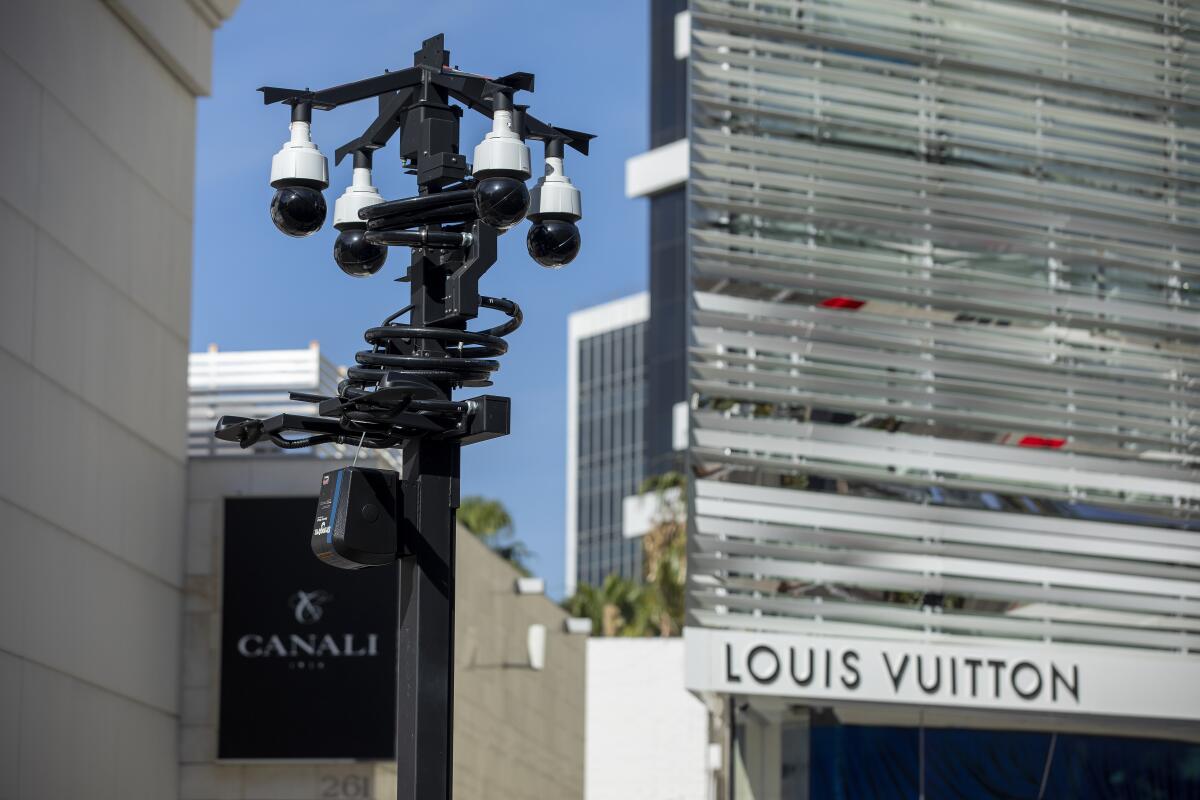
But the city’s technology push is unsettling to civil libertarians and other police critics, who see the blanket surveillance on streets, in parks and elsewhere as an invasion of privacy and a step down a slippery slope of government intrusion into people’s lives.
And with Beverly Hills having come under fire in recent years for allegedly singling out Black and Latino people for arrest and criminal charges, they don’t trust police to use the cameras in an unbiased way.
“When you are in a heavily surveilled environment, the definition of wrong magically expands; people start to become much narrower about what becomes acceptable behavior,” said Shobita Parthasarathy, director of the Science, Technology and Public Policy program at the University of Michigan. “In a community, it could be about noise levels or it could be about how high your grass is growing or about what kind of lawn ornaments you have. And so there are all kinds of things that could become the domain of the criminal justice system.”
On Beverly Hills’ famed Rodeo Drive, police allegedly targeted Black shoppers, who say they feel unwelcome in the wealthy city.
The evidence is also mixed about whether cameras have a direct effect on crime, she said. A 2016 review of several studies found that closed-circuit TV cameras were most effective when combined with other crime-fighting tools such as improved lighting and security guard patrols, but that they hadn’t been shown to reduce violent crime on their own.
Although comparatively tiny, Beverly Hills’ roughly 60 cameras per 1,000 residents ranks it among the most surveilled cities in the world alongside the likes of London and Beijing, according to statistics compiled by the consumer site Comparitech. Los Angeles, by comparison, has roughly 35,000 cameras and 4 million people — or about 9 for every 1,000 residents.
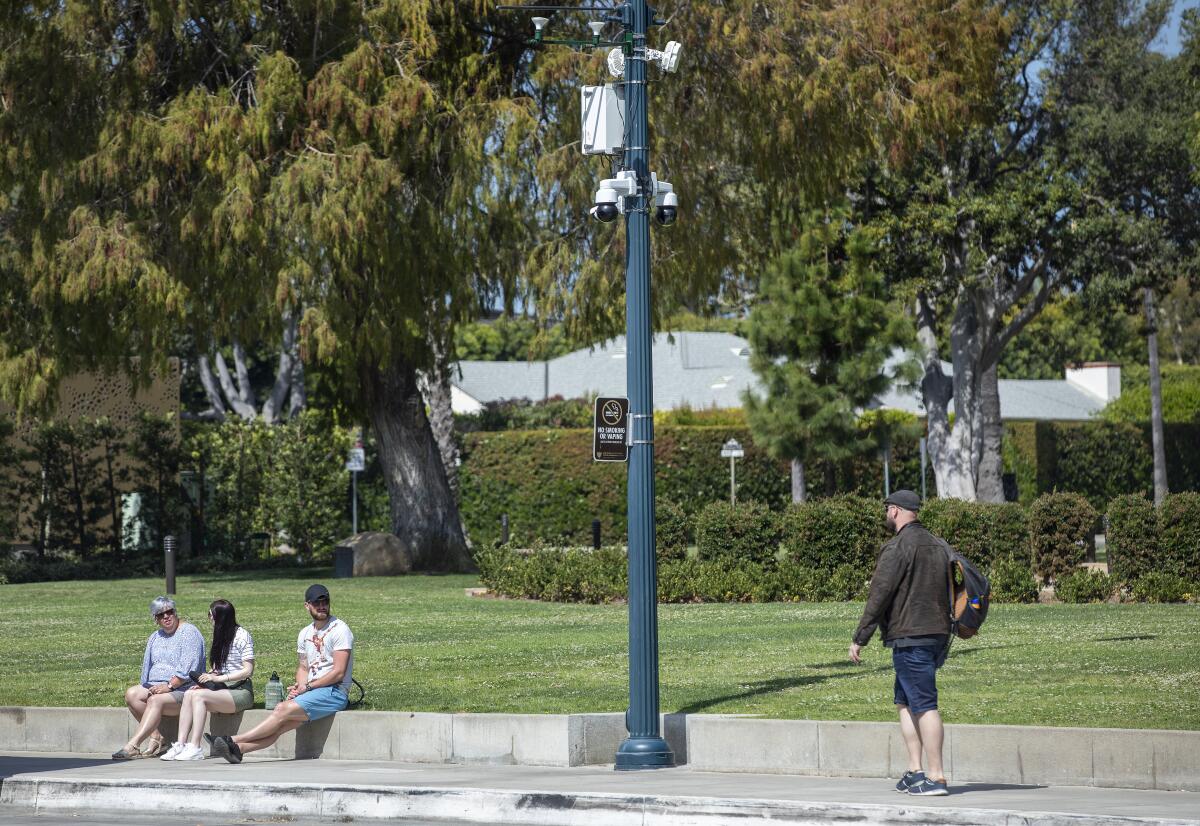
Beverly Hills’ surveillance buildup is part of a broader, years-long push to remake itself into a “smart city,” in which data on many aspects of residents’ and visitors’ lives are collected and analyzed to address common urban challenges such as traffic, sanitation and public safety. City officials envision a wired Beverly Hills of the future with driverless public transit and high-tech cultural venues.
Some of the city’s cameras are in plain view and some inconspicuous. Many are encased in black orbs and are affixed to traffic light poles or installed in city parking garages. Elsewhere, they adorn the sides of boutiques and art galleries, or look down from utility poles in residential areas.
The city has been adding cameras since 2005, and the endeavor picked up significantly in 2018 after the council expanded surveillance into residential neighborhoods, according to minutes from council meetings.
Then came the decision in August 2020 to spend $1.2 million to install the additional 200 cameras throughout the city.
The expansion came at a delicate moment: Earlier that summer, protest groups such as Black Future Project came into the city to hold demonstrations against the murder of George Floyd in Minneapolis and other police abuses, knowing the juxtaposition of Black and Latino protesters in the overwhelming white and rich city would draw attention. Police and the city attorney’s office took a hard line with protesters, making arrests and pursuing prosecutions on minor criminal charges.
The decision to add cameras on the heels of the protests was viewed by critics as an attempt to further boost the city’s ability to tamp down on such dissent and a response to the anxieties of residents unsettled by the sight of protesters taking to city streets to rally against racial injustice.
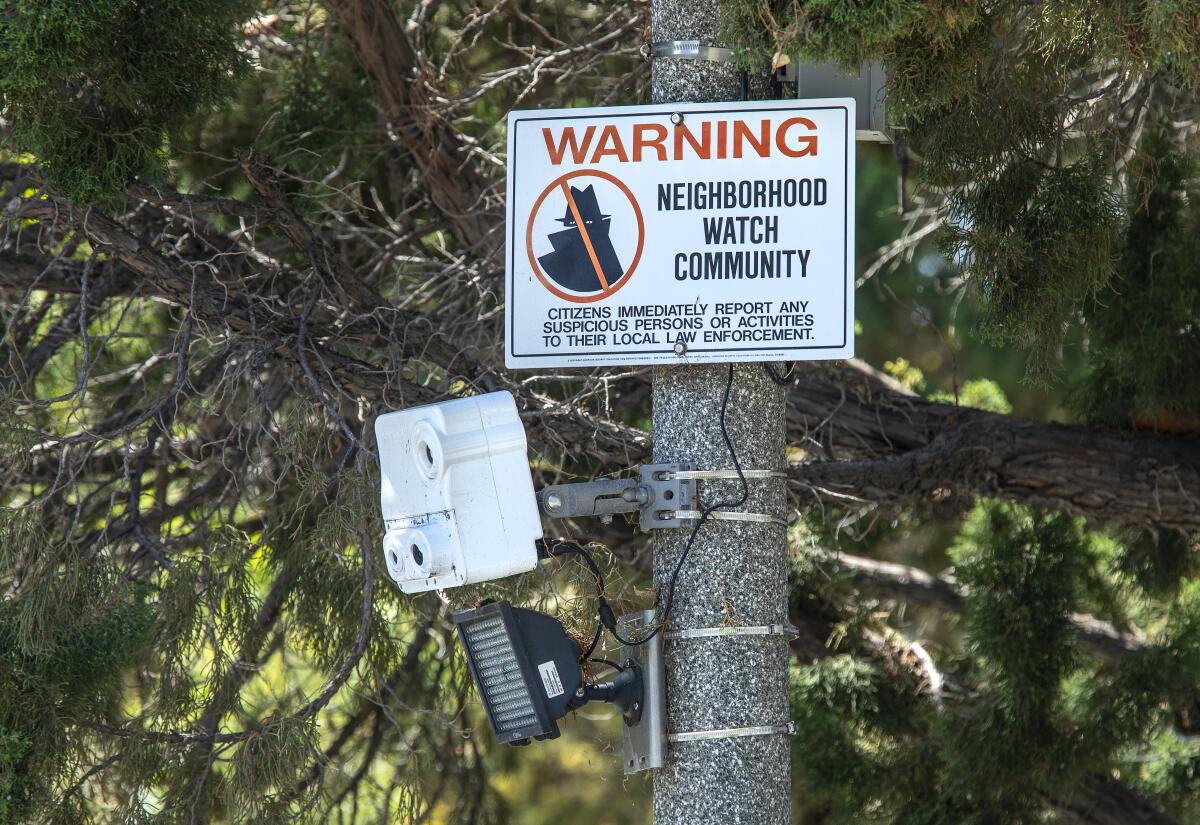
“In a community where people perceive Black people and poor people as threats to their wealth … then people will respond with surveillance systems and strategies to protect what they have at all costs,” said Safiya Noble, co-director of UCLA’s Center for Critical Internet Inquiry, who wrote a book about how search engines can reinforce racial bias.
In the years since, tensions over race and wealth have continued to simmer in Beverly Hills, where the population is 78% white and the median household income in 2020 was $101,241.
A Times report last year found that an overwhelming majority of the people arrested by a special Beverly Hills Police Department detail patrolling Rodeo Drive were Black.
Ninety people were arrested by the unit. Eighty of them were Black, four were Latino, three were white, two were Asian and one was classified as “other.”
The special team was formed amid complaints over what residents and shop owners said was a “criminal element” on Rodeo Drive, and it focused, at first, on curtailing minor infractions like loud music and illegal street vending. Most of the arrests, however, were part of a crackdown on shoppers believed to be part of an elaborate scheme to defraud the state’s unemployment system, records show.
Police have not explained why so many of the arrests were of Black people.
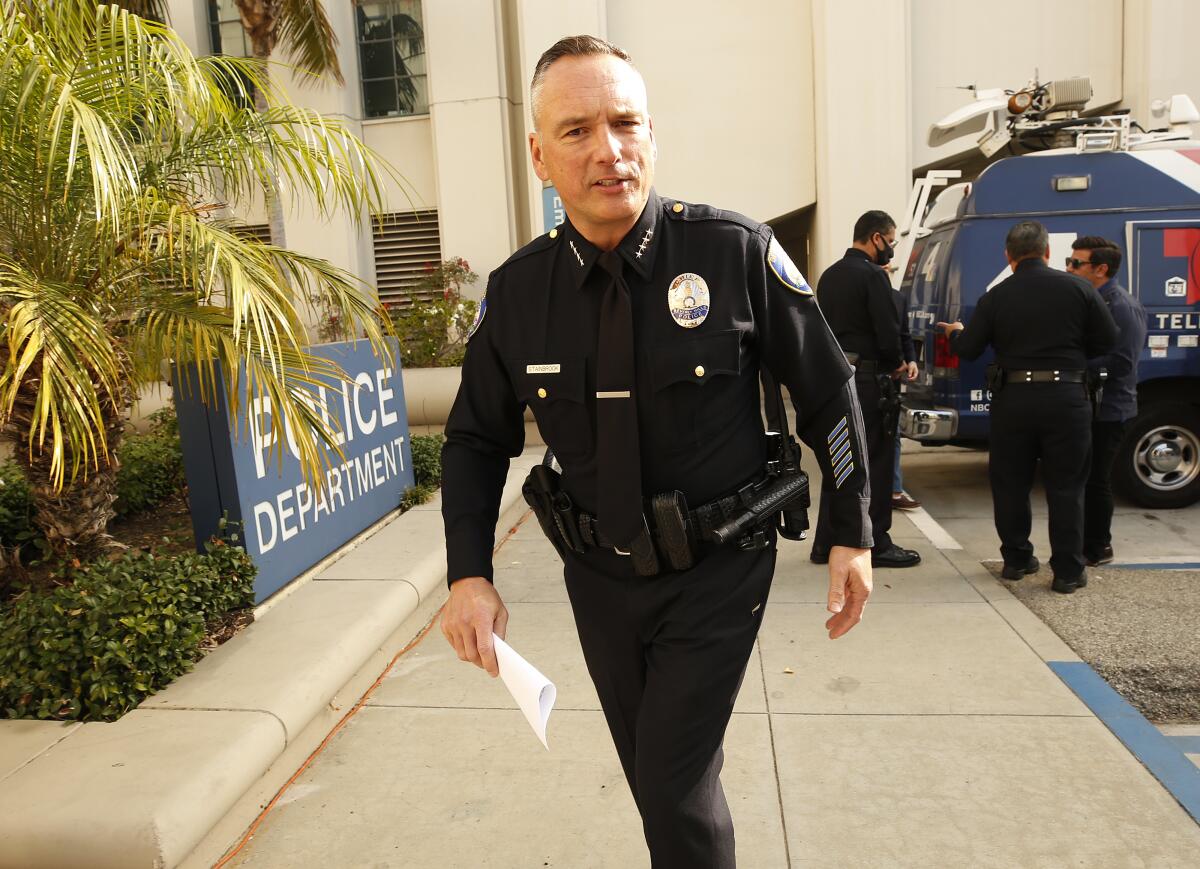
The city’s police chief, Mark Stainbrook, says the cameras have helped solve “dozens” of crimes since he took over the job late last year, including the December slaying of renowned philanthropist Jacqueline Avant and the overdose death of a billionaire’s son. In both cases, detectives used city cameras to stitch together the suspects’ movements.
But he hasn’t always shared the council’s breathless enthusiasm for adding more cameras, saying that before the city thinks about expanding its surveillance any further, it should redeploy its existing cameras to areas with more crime.
“You’d have to ask the people on the council what they think. I’ve always said that you have to evaluate what you have first,” Stainbrook said in an interview a day after sledgehammer-wielding thieves pulled off a daytime robbery, making off with $3 million to $5 million worth of jewelry.

Subscribers get exclusive access to this story
We’re offering L.A. Times subscribers special access to our best journalism. Thank you for your support.
Explore more Subscriber Exclusive content.
At a meeting with the City Council this month, however, Stainbrook floated the idea of building an intelligence center, where feeds from cameras, drones and automated license plate readers could be monitored in real time by private security contractors.
In response to a question from a councilmember, Stainbrook acknowledged some residents have expressed concerns about their privacy being invaded, but said safeguards are in place to prevent misuse of footage. “The data is kept in compliance with state law,” he said.
Currently, Beverly Hills doesn’t have nearly enough cops or civilian employees to monitor live feeds from the cameras, Stainbrook said. Instead, the footage is uploaded to a server, and when a crime occurs, investigators check whether suspects were caught on camera. In the “age of ‘CSI,’” he added, “juries seem less willing to convict someone without video evidence.”
“At least criminals know that when you’re going to come here and commit a crime, you’re going to be on video and we’re going to find and arrest you,” he said.
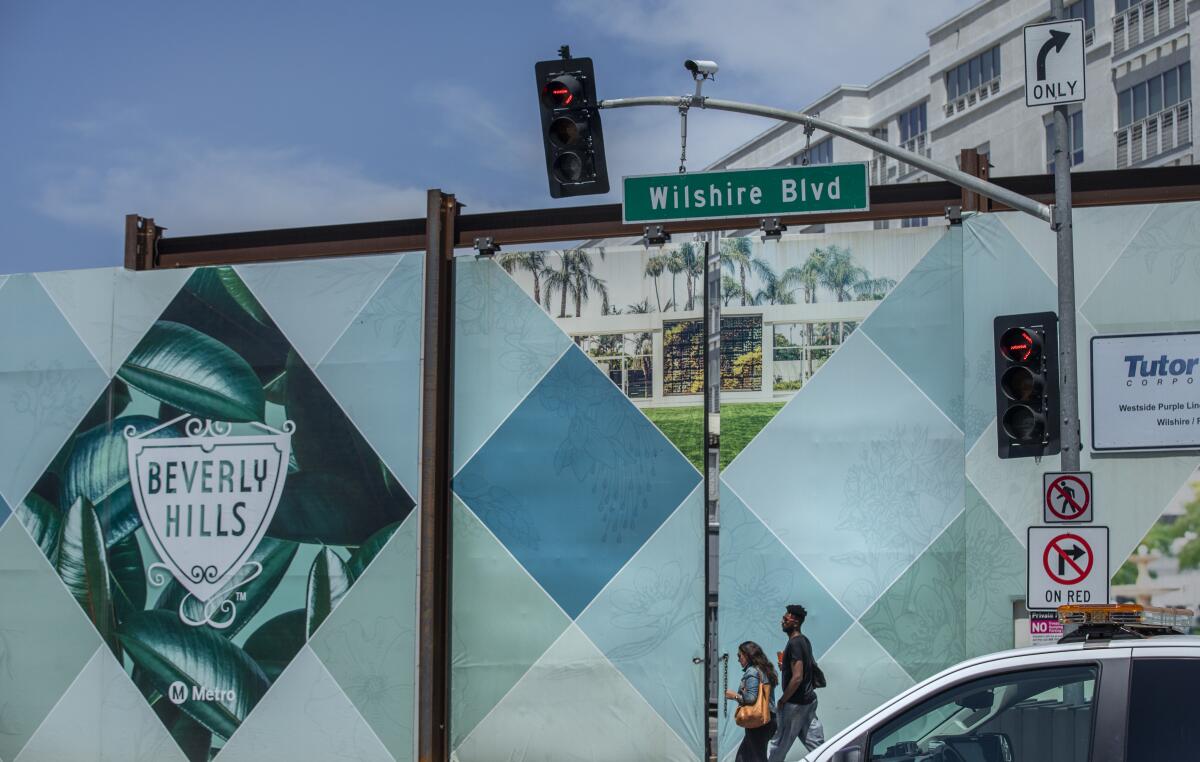
But crime is relatively rare in Beverly Hills, raising the question whether so many cameras is overkill. Preliminary police data showed that even though the number of violent crimes such as robberies and serious assaults rose from 111 to 139 from 2020 to 2021, the overall crime rate declined roughly 2% in that span.
Lili Bosse, a longtime councilmember who recently started her third rotation as mayor, said in an interview that constituents have told her the cameras bring them peace of mind, especially as many of the roughly 7 million tourists who visited the city each year before the pandemic have begun to return. In today’s hyperconnected world, people have grown used to the idea they could be recorded when they leave their homes, she said.
Despite signs posted in commercial and residential areas alerting people to the fact they are on camera, resident Evan Brenner said he was unaware of the city’s surveillance ambitions. He said he can see both sides of the debate.
“I’m kind of torn about it, to be honest with you, because on the one hand you want to feel safe. But on the other hand, who wants strangers watching every move that they make?” said Brenner, who works in real estate. “I don’t like the government intruding on our privacy, and at the same time, if the intention is keeping us safer ... a lot of it has to do with how the technology is used.”
Bosse and her colleagues on the council have suggested the city should find ways to tap into privately owned cameras to further broaden their surveillance capabilities and have endorsed buying artificial-intelligence software that could automatically flag people captured on camera as suspicious based on their appearance or behavior, or scan crowds for the face of a person with a warrant.
“I would be willing to spend more money, if necessary, to ... find the most robust artificial intelligence we can find that could be adapted to a policing environment,” Councilmember Bob Wunderlich said at the meeting this month. Stainbrook demurred, saying that while the department will eventually use such technology to automatically read and interpret footage from the city’s cameras, the potential upsides and pitfalls need to be studied more thoroughly.
Wunderlich said the department is already using a type of AI technology from a company called BriefCam, but did not elaborate. Later in the meeting, Stainbrook explained that state law bars the use of facial recognition on police cameras, but BriefCam makes it possible to “review hours and hours of video and hone in on certain cars or times, locations, people, descriptions” to help authorities “quickly locate people.”
Beverly Hills has in recent years moved aggressively to establish itself as a technology innovator. In 2015, Google named it California’s eCity of the Year, and the following year the city adopted a resolution supporting self-driving vehicles as a form of public transit.
That same year, it also laid fiber optic cable that now carries fast broadband internet service into every business and home, while powering the city’s free public Wi-Fi network.
The ubiquitous Ferraris and Bentleys and Lamborghinis of Beverly Hills may soon be sharing the road with a new form of auto exotica: robot cars.
Still, some U.S. cities are starting to second-guess their use of such technology. In 2020, the mayor of San Diego ordered the shutdown of the city’s Smart Streetlight camera network over privacy issues, while Seattle began to dismantle its $3.6-million network of linked surveillance cameras and other wireless devices after public complaints over government overreach.
At the same time, a small but growing number of places have in effect banned law enforcement use of facial recognition, citing studies showing that the technology can have a hard time positively identifying women and people of color.
Cities like Beverly Hills need to have strict rules and policies on when and where such technologies are deployed, with adequate public discussion, according to Hannah Zhao, a staff attorney with the Electronic Frontier Foundation. The trouble, she says, is that city officials eager to be out front in the digital revolution often don’t fully understand the consequences of handing over so much data to private companies.
Any discussions about the trade-offs between efficiency and security and people’s civil liberties should involve the community, she said.
In 2020, Beverly Hills officials said they take potential risks seriously, and pledged $7.4 million for cybersecurity enhancements.
Some cities that have adopted smart technologies “don’t even have general policies about who is collecting the data, who is allowed to see the data, and whether it can be used for other purposes,” Zhao said. “If those policies are absent, then we should be very, very worried about this Big Brother-style environment that we live in.”
More to Read
Sign up for Essential California
The most important California stories and recommendations in your inbox every morning.
You may occasionally receive promotional content from the Los Angeles Times.
